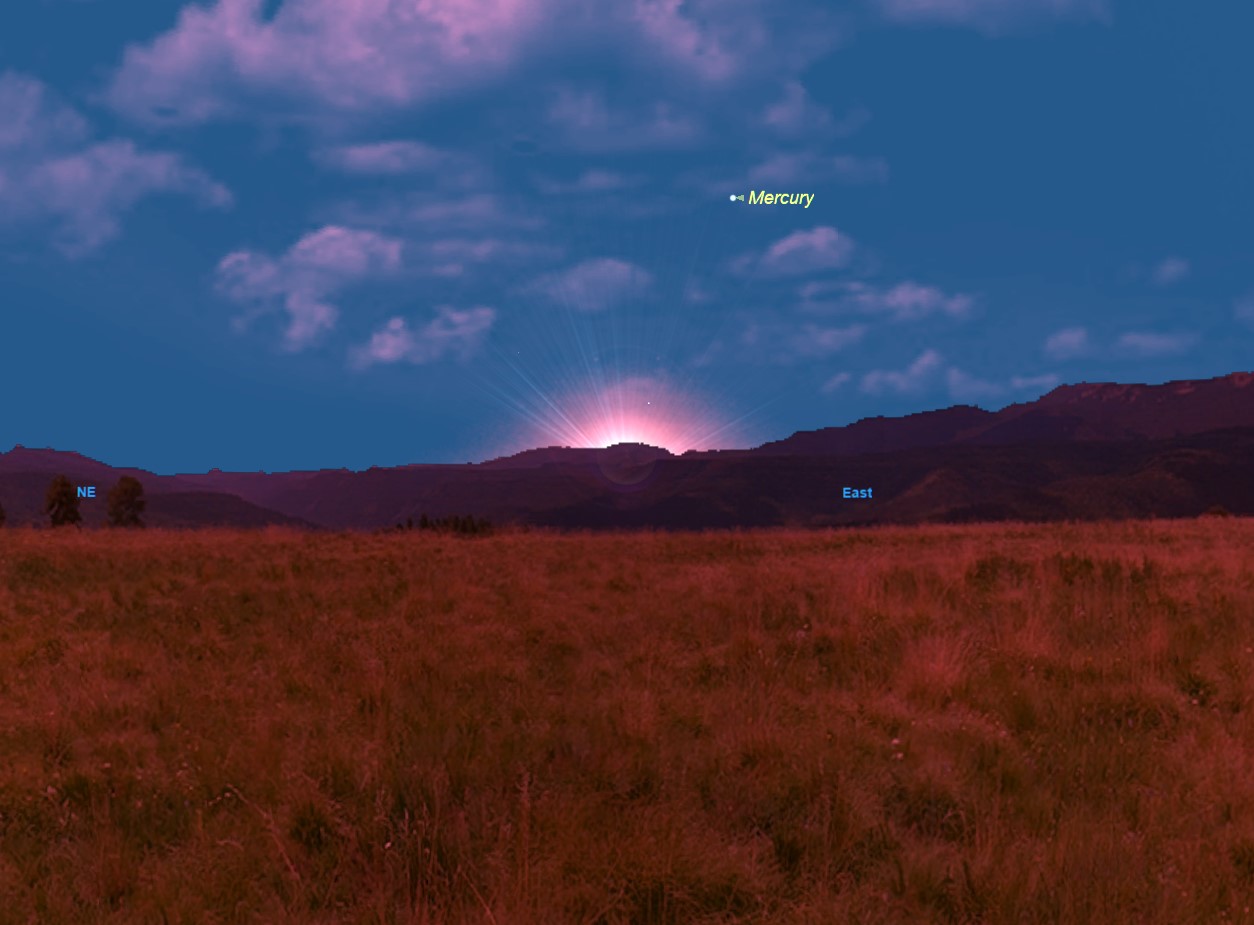A Half-Lit Mercury Rises Early Tuesday: How to See It

The planet Mercury will reach half phase tomorrow (Aug. 28) and will be visible early in the morning before dawn.
Mercury has phases similar to Earth's moon. At 7:01 a.m. EDT (1101 GMT), Mercury will be at dichotomy, which means that half of its Earth-facing side will be illuminated by the sun. For skywatchers on the East Coast, this will happen after sunrise, when Mercury will have faded into the daylight. However, skywatchers will have a chance to see it just above the eastern horizon for about 1.5 hours before sunrise.
The event comes just two days after Mercury reached its greatest western elongation, or farthest distance west of the sun, on Sunday (Aug. 26). Because Mercury lingers so close to the sun, it can be difficult to see through the sun's blinding glare. This trait has earned Mercury the nickname "the elusive planet." The farther Mercury is from the sun , the easier it is to see. On Sunday evening, Mercury reached its maximum separation of 18.3 degrees to the west of the sun. By tomorrow morning, it will have crept only about one-tenth of a degree closer to the sun. [The Brightest Planets in the August 2018 Night Sky]
While the tiny, innermost planet can be spotted with the naked eye, a telescope is needed to make out its phases, according to Space.com skywatching columnist and FiOS1 News meteorologist Joe Rao. "Compared to the other planets that are currently stretched out across our evening sky, Mercury's current morning apparition displays a rather small disk ... only about 7 arc seconds in diameter," Rao told Space.com in an email. For contrast, the moon's apparent diameter is 30 arc minutes, on average.
"This means that if you wanted to make [Mercury] appear through the eyepiece as large as the moon does to our naked eye, you would need a magnification of 250 power," Rao said. "While most any scope can do that, it is best to use one with a moderately large aperture ... say, a 10-inch or larger."
For skywatchers in New York City, Mercury will rise in the east at 4:45 a.m. local time, or 1 hour and 33 minutes before sunrise, according to the skywatching website in-the-sky.org. It will fade from view before the sun peeks over the horizon, though, as dawn will break around 6 a.m. local time. Mercury's proximity to the horizon may also pose a challenge for observers. In New York, it will appear no more than 11 degrees above the horizon. (If you clench your fist and hold it at arm's length, it will measure about 10 degrees wide.)
"Because Mercury is also at a rather low altitude in the east-northeast sky at dawn, atmospheric conditions near the horizon will likely make for rather turbulent conditions," Rao said. "So, it certainly is worth looking for Mercury, but so far as viewing it through a telescope, it might well be a disappointing sight (though even a somewhat distorted view should reveal that you're looking at only half of a disk)."
Breaking space news, the latest updates on rocket launches, skywatching events and more!
Mercury will return to the spotlight on Nov. 6, when the planet reaches is greatest eastern elongation. This happens about seven weeks after Mercury passes behind the sun's far side on Sept. 20. To find out exactly when and where Mercury and the other planets are visible from a specific location, check out these handy calculators at heavens-above.com and timeanddate.com.
Email Hanneke Weitering at hweitering@space.com or follow her @hannekescience. Follow us @Spacedotcom, Facebook and Google+. Original article on Space.com.

Hanneke Weitering is a multimedia journalist in the Pacific Northwest reporting on the future of aviation at FutureFlight.aero and Aviation International News and was previously the Editor for Spaceflight and Astronomy news here at Space.com. As an editor with over 10 years of experience in science journalism she has previously written for Scholastic Classroom Magazines, MedPage Today and The Joint Institute for Computational Sciences at Oak Ridge National Laboratory. After studying physics at the University of Tennessee in her hometown of Knoxville, she earned her graduate degree in Science, Health and Environmental Reporting (SHERP) from New York University. Hanneke joined the Space.com team in 2016 as a staff writer and producer, covering topics including spaceflight and astronomy. She currently lives in Seattle, home of the Space Needle, with her cat and two snakes. In her spare time, Hanneke enjoys exploring the Rocky Mountains, basking in nature and looking for dark skies to gaze at the cosmos.

